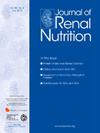The 10-Item Physical Function Scale as a Sarcopenia Screening Tool for Patients on Hemodialysis
IF 3.4
3区 医学
Q2 NUTRITION & DIETETICS
引用次数: 0
Abstract
Objective
We investigated the accuracy of the 10-item Physical Function (PF-10) questions of the SF-36 quality of life questionnaire as a sarcopenia screening tool among patients on hemodialysis.
Methods
A cross-sectional, multicenter study that included adult patients on hemodialysis. The revised European Working Group on Sarcopenia in Older People was used to diagnose sarcopenia. The 10 questions about daily activities from the SF-36 quality of life questionnaire were used to appoint the PF-10, where the final score could range from 10 to 30, and the lower the worse the physical function. The PF-10 accuracy to identify confirmed sarcopenia (low muscle strength + low muscle mass) was assessed through a receiver operating characteristic curve and the cutoff was calculated using the Youden index.
Results
One hundred eighty-five patients were included (median 59 years; 45% female). Prevalence of confirmed sarcopenia was 31.4%. The median PF-10 score was 23 (interquartile range: 17–27) and a significant association with all sarcopenia measurements was found (all P < .05). The best cutoff calculated from the receiver operating characteristic curve was ≤26 points (area under the curve = 0.69, 95% confidence interval 0.61-0.77) with sensitivity and specificity of 96.6% and 71.0%, respectively. Moreover, patients with ≤26 points (n = 133, 72%) had a higher prevalence of low muscle strength by handgrip (53 vs. 19%; P < .001) and 5-time sit-to-stand (41 vs. 10%; P < .001), low gait speed (44 vs. 19%; P = .002), confirmed sarcopenia (39 vs. 11%; P < .001), and severe sarcopenia (26 vs. 4%; P = .001), but not low muscle mass (49 vs. 35%; P = .08), in comparison with those >26 points (n = 52, 28%).
Conclusion
The PF-10 may be a useful physical dysfunction and sarcopenia screening tool in patients on hemodialysis. A PF-10 threshold of around 26 points appeared to display the fairest accuracy for diagnosing sarcopenia.
作为血液透析患者 "肌肉疏松症 "筛查工具的 10 项身体功能量表 (PF-10)。
目的:临床实践中非常需要用于评估肌肉疏松症的筛查工具。一些透析中心通常通过 36 项简表调查(SF-36)来评估生活质量,其中包括 10 个有关身体功能的问题。因此,我们研究了 10 项身体功能量表(PF-10)识别血液透析患者肌少症的准确性:方法:这是一项横断面多中心研究,研究对象包括接受血液透析的成年患者。采用欧洲老年人肌肉疏松症工作组的修订版来诊断肌肉疏松症。采用 SF-36 问卷中有关日常活动的 10 个问题来指定 PF-10,最终得分范围为 10 至 30 分,得分越低,身体功能越差。通过接收器操作特征曲线(ROC)评估了 PF-10 对确诊肌肉疏松症(低肌力+低肌肉质量)的准确性,并使用尤登指数计算了分界点:共纳入 185 名患者(中位年龄为 59 岁;45% 为女性)。证实患有肌肉疏松症的比例为 31.4%。PF-10 评分的中位数为 23(四分位数间距:10-30),与所有肌肉疏松症测量值均有显著关联(P 均小于 0.05)。根据 ROC 曲线计算得出的最佳临界值为≤ 26 分(曲线下面积 = 0.69,95% 置信区间为 0.61-0.77),灵敏度和特异度分别为 96.6% 和 71.0%。此外,≤26 分(133 人,72%)的患者手握肌力低下的发生率更高(53 对 19%;P 26 分(52 人,28%)):10项身体功能量表(PF-10)可能是血液透析患者身体功能障碍和肌肉疏松症筛查的有用工具。26分左右的PF-10临界值似乎最能准确诊断肌少症。
本文章由计算机程序翻译,如有差异,请以英文原文为准。
求助全文
约1分钟内获得全文
求助全文
来源期刊

Journal of Renal Nutrition
医学-泌尿学与肾脏学
CiteScore
5.70
自引率
12.50%
发文量
146
审稿时长
6.7 weeks
期刊介绍:
The Journal of Renal Nutrition is devoted exclusively to renal nutrition science and renal dietetics. Its content is appropriate for nutritionists, physicians and researchers working in nephrology. Each issue contains a state-of-the-art review, original research, articles on the clinical management and education of patients, a current literature review, and nutritional analysis of food products that have clinical relevance.
 求助内容:
求助内容: 应助结果提醒方式:
应助结果提醒方式:


